Millions of Americans have changed their religion over the course of their lifetimes, switching from one religion to another, leaving religion altogether, or choosing to identify with a religion after having grown up without one.
If Protestants are counted as a single category – rather than separated into subgroups such as Baptists, Methodists, Lutherans, etc. – then the 2023-24 Religious Landscape Study (RLS) finds that 35% of U.S. adults were raised with a different religious identity than the one they have now.
This is roughly on par with what we found in the 2014 RLS, using the same definition of switching. At that time, 34% of Americans were categorized as having switched religions when Protestantism was treated as a single group.
(By this definition, religious switchers would include – to give just a few examples – a person who was raised Protestant and is now religiously unaffiliated; a person who was raised Catholic and now identifies as any kind of Protestant; a person who was raised in no religion but now identifies as Jewish; and a person who was raised as an Orthodox Christian and now identifies as a Catholic. However, a person who was raised as a United Methodist and now identifies as a Southern Baptist would not be considered to have switched religions, because both of those denominations are Protestant. Similarly, a person who was raised with no particular religion and now identifies as an atheist would not be counted as having switched, because both of those categories are part of the religiously unaffiliated grouping.34)
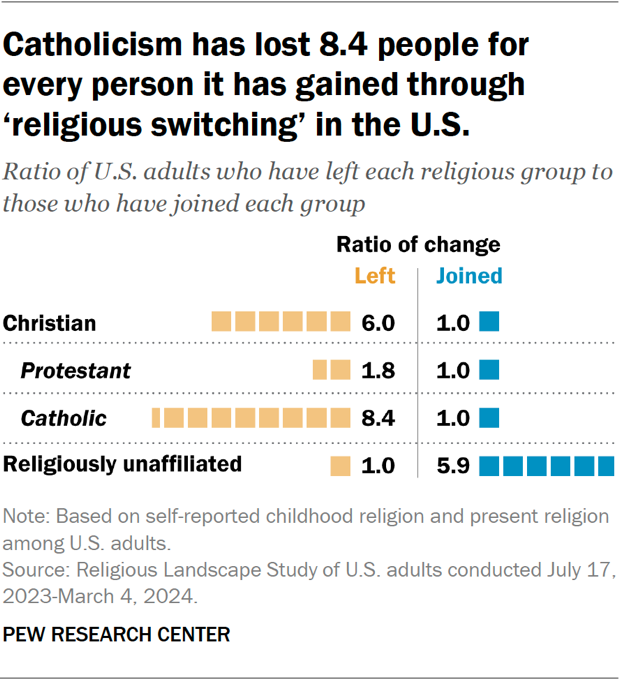
The overall patterns of religious switching in the 2023-24 RLS are similar to the patterns that appeared in the previous landscape studies. Christianity, as a whole, continues to lose more adherents than it gains through switching: For every American who has become Christian after having been raised in another religion or no religion, six others have left Christianity and now describe themselves as religiously unaffiliated, as belonging to another – i.e., non-Christian – religion, or they don’t answer the question about their current religion.
Both Protestantism and Catholicism experience net loss from switching. In the 2023-24 RLS, 1.8 people have left Protestantism for every person who has become a Protestant after having been raised in another religious group or in no religion. The ratio for Catholicism is even more lopsided: For every U.S. adult who has become a Catholic after being raised in some other religion or without a religion, there are 8.4 adults who say they were raised in the Catholic faith but who no longer describe themselves as Catholics.35
Pew Research Center uses the term “religious switching” rather than “conversion” to reflect the fact that movement occurs in all directions and is not necessarily accompanied by any rituals.
The category that has grown the most through religious switching is the religiously unaffiliated population. This group is sometimes called the “nones” and is made up of Americans who answer a question about their present religion by saying they are atheist, agnostic or “nothing in particular.” For every person who was raised as a “none” and now identifies with a religion, 5.9 people have switched away from their childhood religion and no longer identify with any religion.
This chapter details the religious switching among U.S. religious groups. We show both sides of the equation: how many U.S. adults have entered and left each group. We also show the retention rates of the large groups: what percentage of all people raised in a religious group as children remain in it as adults.
In addition, this chapter explores a pair of questions asking respondents to evaluate, in broad terms, how they have changed religiously and spiritually as they have aged.
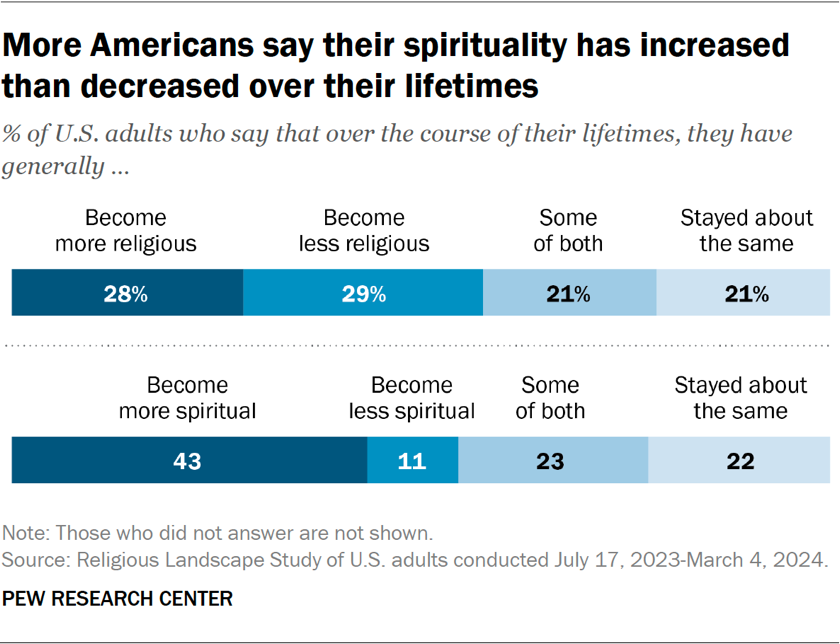
When asked how their religiousness has changed, 28% of Americans say they have become more religious, while roughly the same share – 29% – say they have become less religious. The remainder describe their religiousness as unchanged (21%), say they have sometimes grown more religious and other times less so (21%), or they decline to answer the question (1%).
When asked how their spirituality has shifted over the course of their lifetimes, more U.S. adults say it has increased (43%) than decreased (11%). The remainder say their level of spirituality has stayed about the same (22%), indicate that it has sometimes risen and sometimes fallen (23%), or they give no answer (1%).
Jump to sections on:
- Net gains and losses among religious traditions
- Net gains and losses among Protestant denominational families
- Retention among religious traditions
- Retention among Protestant denominational families
- Change in religiousness over time
- Change in spirituality over time
Net gains and losses among religious traditions
Religiously unaffiliated Americans have experienced the greatest net gains, as a share of the U.S population, through religious switching.
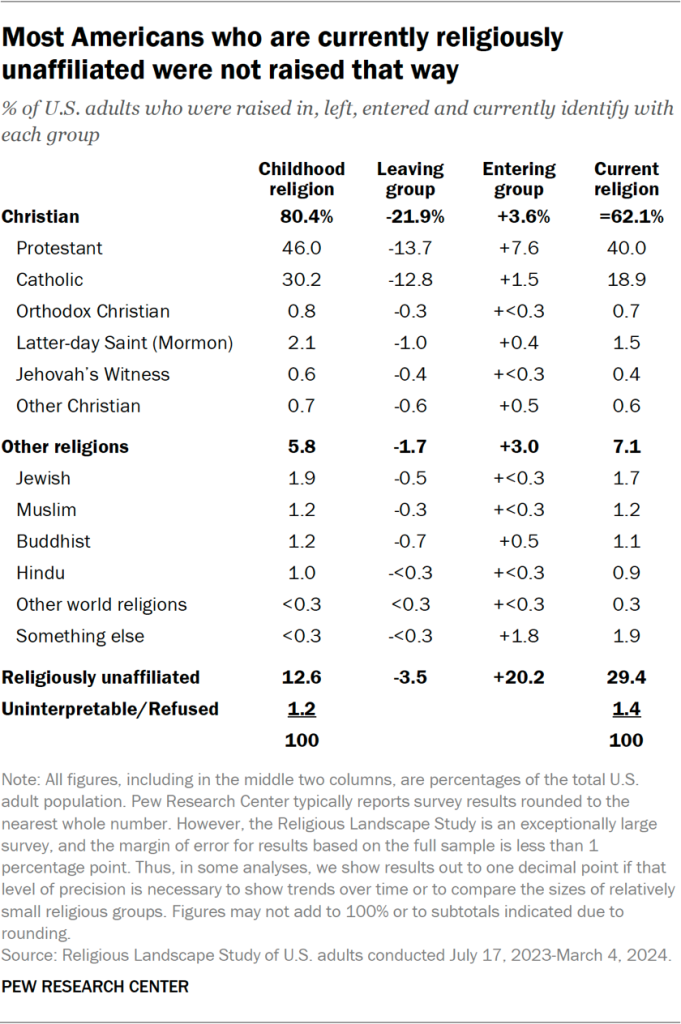
Among all U.S. adults, 12.6% say they were raised with no religious affiliation (as atheist, agnostic or “nothing in particular”). About a quarter of that group – 3.5% of all U.S. adults – no longer identify as religious “nones.” Instead, they now identify with a religion (or, in a small number of cases, decline to answer the religion question).
Still, the share of people who have joined the ranks of the “nones” is nearly six times larger: 20.2% of all U.S. adults were raised in a religion and now identify as religiously unaffiliated.36
The picture is reversed for Christianity. Overall, 21.9% of U.S. adults are former Christians – people who say they were raised as Christians but no longer identify as such. That’s six times higher than the share of U.S. adults who now identify as Christians after having been raised in some other way (3.6%).
Catholics have experienced the greatest net losses due to switching. About three-in-ten U.S. adults (30.2%) say they were raised Catholic. But 43% of the people raised Catholic no longer identify as Catholic, meaning that 12.8% of all U.S. adults are former Catholics. Meanwhile, on the other side of the ledger, 1.5% of U.S. adults have become Catholics after being raised another way. Overall, 18.9% of U.S. adults currently identify as Catholics, according to the new RLS.
Protestantism also has lost more people than it has gained through religious switching. Overall, 13.7% of U.S. adults say they no longer identify with the group after having been raised as Protestants, compared with 7.6% of Americans who were not raised Protestant but now identify as such.
We found similar religious switching patterns in our 2014 Religious Landscape Study.
To put some of these percentages in context, there were approximately 262 million adults (ages 18 and older) in the United States in 2023, according to the U.S. Census Bureau. That means:
- About 91 million U.S. adults (35%) have switched their religion since childhood – including more than 9 million (3.6%) who have become Christians and more than 57 million (21.9%) who have left Christianity.
- Meanwhile, about 53 million (20.2%) have become religiously unaffiliated, while about 9 million (3.5%) have joined a religion after being raised without one.
Net gains and losses among Protestant denominational families
Several Protestant denominational families have lost more people than they have gained through religious switching.

For example, 7.5% of U.S. adults say they were raised Baptist but no longer identify as Baptist, compared with 3.3% of U.S. adults who were not raised Baptist but who now identify with the group.
Nondenominational Protestants are an exception to this pattern. While 1.7% of U.S. adults say they were raised as nondenominational Protestants and no longer identify as such, more than three times as many now describe themselves as nondenominal Protestants after having been raised another way (5.7%).
There were similar patterns in Protestant denominational switching in the 2014 RLS.
Retention among religious traditions
The previous analysis in this chapter looked at the shares of all U.S. adults who say they were raised in various religious groups, what percentages have left each group, and what percentages have joined each group after having been raised in some other way.
Another way to examine the data is by looking at “retention rates.” Among the people raised in a particular religious group, what percentage continue to identify with that group as adults?
At least three-quarters of Americans who were raised Hindu (82%), Muslim (77%) and Jewish (76%) still identify with those religious groups in adulthood. Among people raised as Hindus, 11% are religious “nones” today, as are 13% of those raised Muslim and 17% of those raised Jewish.
Seven-in-ten adults who were raised Protestant still identity as Protestant as adults, while 22% of people raised as Protestants say they are now religiously unaffiliated.
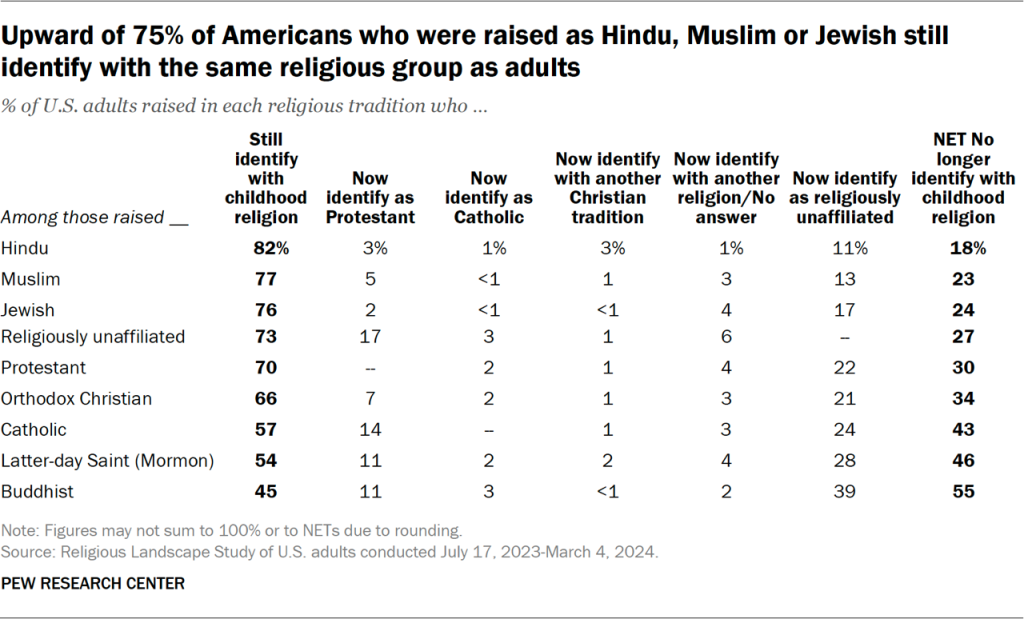
Among people who were raised Catholic, 57% still identify as such as adults. About a quarter of people who were raised Catholic now say they are religiously unaffiliated (24%), and 14% of people raised as Catholics identify as Protestant today.
Nearly three-quarters of those raised religiously unaffiliated (73%) have remained religious “nones” as adults. Most of those who were raised as “nones” but have since changed affiliations now identify as Protestants (17%).
The retention rate among religious “nones” in the 2023-24 RLS is significantly higher than it was in the 2014 RLS. At that time, 53% of Americans who were raised without a religious affiliation continued to identify as unaffiliated in adulthood. The share of people raised as “nones” who say they are still “nones” has gone up across all age categories since 2014.
In general, the retention rate of those raised as “nones” is higher among younger adults than it is among older people. For instance, among adults born between 2000 and 2006 (who were between the ages of 18 and 24 when the 2023-24 survey was conducted), 79% of those raised as “nones” are still religiously unaffiliated today, as are 80% among people born in the 1990s who were raised as “nones.” By comparison, among those born in the 1960s who were raised as “nones,” 61% are still “nones” today, as are 60% of people born in the 1950s who were raised as “nones.”
Retention among Protestant denominational families
Baptists, Lutherans, Pentecostals and nondenominational Protestants have among the highest retention rates of Protestant denominational families in the 2023-24 RLS. More than half of Americans who were raised Baptist (54%) still identify as Baptists as adults; 47% raised Lutheran still identify as Lutherans; and 45% raised Pentecostal or nondenominational still identify that way as adults.
Among all U.S. adults who were raised Protestant, 44% still identify with the same denominational family as they did as children, while 26% identify with a different one. An additional 22% are religiously unaffiliated, 2% identify as Catholic, and 4% identify with another religion.
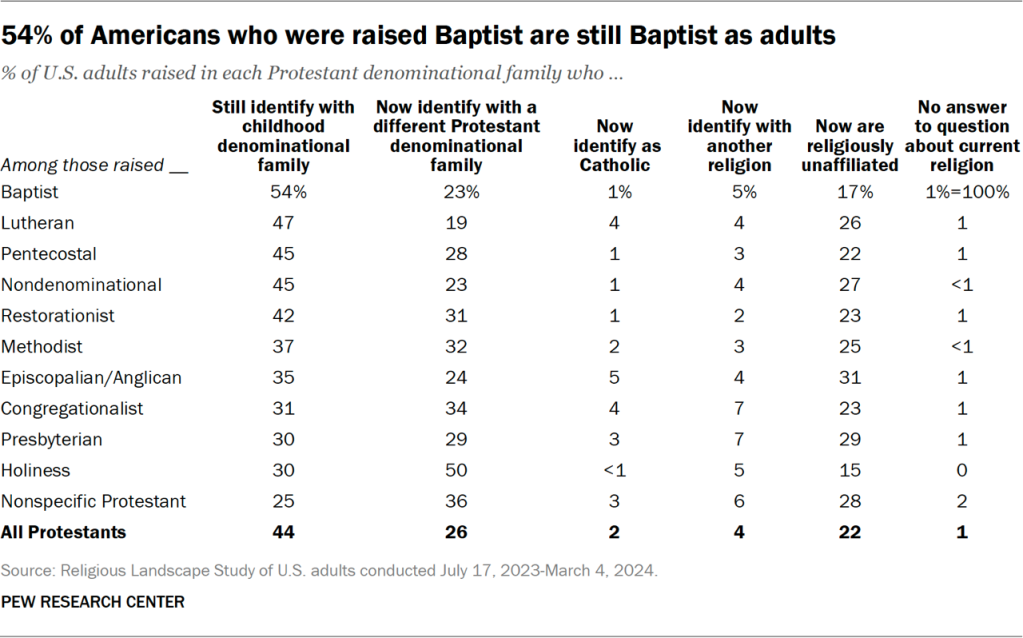
Change in religiousness over time
About eight-in-ten Americans say their religiousness has shifted during their lifetimes, including 28% who say they have become more religious, 29% who say they have become less religious, and 21% who say their religiousness has fluctuated, sometimes increasing and other times decreasing. About one-in-five (21%) say their religiousness has stayed about the same over the course of their lives.37
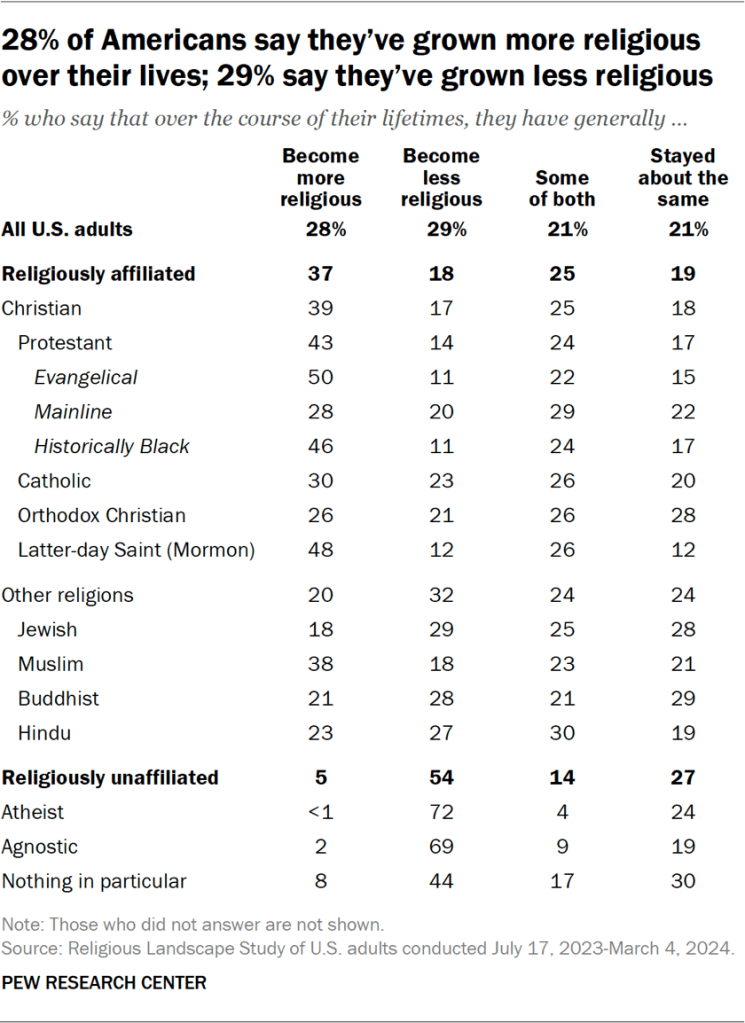
Evangelical Protestants (50%); people who identify with the Church of Jesus Christ of Latter-day Saints, who are widely known as Mormons (48%); and members of historically Black Protestant churches (46%) are especially likely to say they have become more religious during their lifetimes. Religiously unaffiliated adults are the most likely group to say they have become less religious (54%).
Change in spirituality over time
On a parallel question about spiritual change, 43% of Americans say they have generally become more spiritual during their lifetimes, while 11% say they have become less so. An additional 23% say they sometimes have grown more spiritual, other times less so. And 22% say their level of spirituality has stayed about the same.38
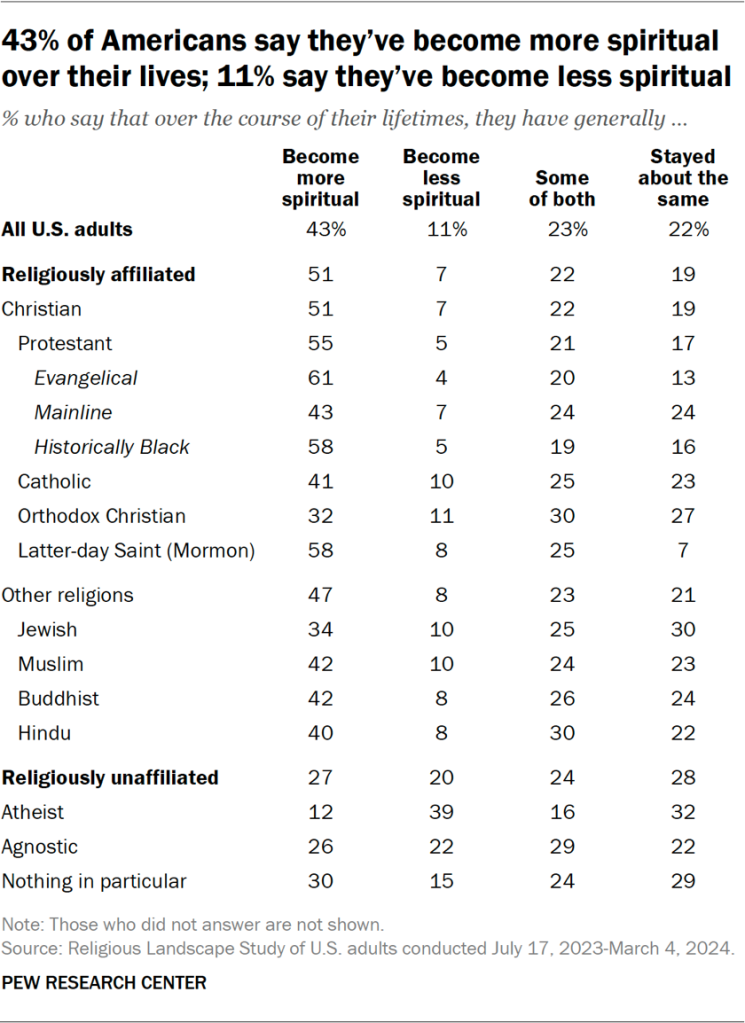
About six-in-ten members of evangelical Protestant (61%) and historically Black Protestant (58%) denominations say they have become more spiritual over their lifetimes. A similar share of Latter-day Saints say this (58%).
The survey finds that 43% of mainline Protestants, 42% of Muslims, 42% of Buddhists, 41% of Catholics and 40% of Hindus say they have grown more spiritual over time.
About a third of Jews (34%) and 27% of religiously unaffiliated adults say they have become more spiritual over the course of their lives.




